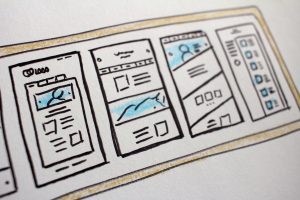The benefits of a website as a coach
Dig into the detail of what having a website could be doing for your coaching business.

Starting a business is a pain in the butt. There, I said it.
When starting, there are a million jobs that you have to do. As a business owner, you end up doing the whole lot by yourself.
We always hear that prioritising tasks is a great way to keep your goals on target, but building a website is kicked to the curb.
As I said last week, I spend a lot of time in Facebook Groups for business and leisure interests. A couple of my groups are education, coaching or training focused. As a lifelong learner, I find the conversations fascinating. Whilst doing my rounds a couple of weeks ago, I came across quite a few posts discouraging coaches from creating websites. I was shocked at the misinformation, so I figured this would be a great post to cover.
I’m aware that we’re a web design agency, so we’ll always be singing the praises of building a website, but coaching is a profession that can truly benefit from it.
Suppose you’re a coach, trainer, therapist or teacher. Here is the main reason that I’d suggest running a website for your business.
Trust and its importance within the coaching professions
The jobs in the training or coaching professions always begin with a problem.
– A client will have an idea about something that they need/want to learn.
– They’ll be aware that there is an issue that they need help resolving.
– The client might have experienced something that they want to discuss.
– Sometimes, the client might be seeking personal or business based growth.
If you put yourself in the clients’ shoes for a moment, what would you need before deciding who could help you?
It’s unlikely that they’ll ask an unknown person to help them with an issue. They might ask for the advice of friends or family; they might ask for recommendations from other people through these pathways. Others might do a detailed search online to find the right person.
But what do both of these client types have in common?
They’re all looking for signs of trust. The search and comparison section of any buying cycle is about proving that you are trustworthy. When I’m talking about trust, I don’t necessarily mean trust in terms of secret-keeping. I’m talking about the faith that a client has in you to do a good job. Unless the person knows you directly, the trust level begins at zero. You then have multiple opportunities to build that trust level.
One of the ways that trust can be built is through your website. In fact, by having a website, you’re a step ahead of the game. The majority of small businesses still don’t run a website. You could be even more ahead if you regularly maintain the website you have, but that’s a whole other conversation.
So, it’s easy to say that a website builds trust, but how?
The Search Trust – This is part of what we’ve discussed above. The potential client searches for you after Googling or hearing about you from someone, and they come across you on the web. This is the first confirmation that you are more than just a name, indicating that you’re running a reputable business. You can’t reach the subsequent layers of trust if you don’t start with this one, so keep that in mind.
The Layout Trust – Once the client is on your website, they want answers to their questions. This is where the wireframing and customer journey comes into play. A website with thorough wireframing will lead the client down the page in the right way through navigation bars, leading icons or content cues. For this section, your web developer/designer would be thinking about why the viewer has come to the page; what information do they want quickly?
From the viewers perspective, what does this mean?
Let’s say the viewer has already bought into what you’re selling and wants more direct info from you. The first thing that they’ll be looking for is your contact information. If the viewer has to dig through written content to find your phone number or email address, they will lose trust rather than build it.
Maybe your viewer wants to know more about an event or seminar you’ve been promoting on social media or via word of mouth. Again, this content should be front and centre for the viewer. The key here is that we don’t want the potential client to have to dig. We want the experience to confirm their belief that you are the right person to help them.
The Content Trust – Content and layout are heavily intertwined, but it’s worth mentioning here as well. We all have different levels of trust and various capacities for information gathering. Some people want to hear the words directly from your mouth, and others will want in-depth information on the website that they can use as a measurement tool. But how does the website satisfy the need for information without turning it into a book?
There are different types of content scattered through a website that suit the different types of people. For example;
- You’ll usually have a services section that dives deep into the services that you provide (over 500 words),
- Your home page works as the tree to guide people where they’d like to go, so this will have less detailed information, but it might have statistics, quotes that catch the eye or a storytelling theme that captures attention.
- The reviews on a website are a HUGE trust factor; this again comforts the viewer knowing that other people recommend your services.
- A blog is where you take parts of your business and dive deeper into them. If you keep this updated weekly, the more, the better.
Each piece of content should be carefully tuned to guide your reader, and there are loads more examples that we could give for content building trust, but you get the idea.
The Online to In-Person Factor – Finally, the potential client has contacted you and set up to meet in person or via Zoom, which is the final trust factor. Once they jump and are in person with you, they should see the coach reflect the website to them. The idea is that the customer should get a great view of who you are through the website and then continue seeing the same persona when you meet. This confirms their trust in understanding who you are and allows them to open up.
All in all, it comes down to trust and helping build that in your potential clients before they meet you. The main takeaway is that you’re trying to fill a trust meter, it’s easy to drop points from the trust meter, but if you can fill it up then, you’re likely to find more clients and have better outcomes with them when you get to work!
Whether you’re a coach, therapist or educator, a website needs to be built with your business in mind. If you’d like to chat through your website idea with us, please follow this link and we will set up a chat in Maidenhead or surrounding areas!
If you enjoyed reading this blog post, check out similar ones in the sidebar. Feel free to get in touch with to chat about your latest project ideas - we love a good excuse for more tea.


These are definitely some great benefits. Thanks so much for sharing all this info!
Thanks for having a read Charity!